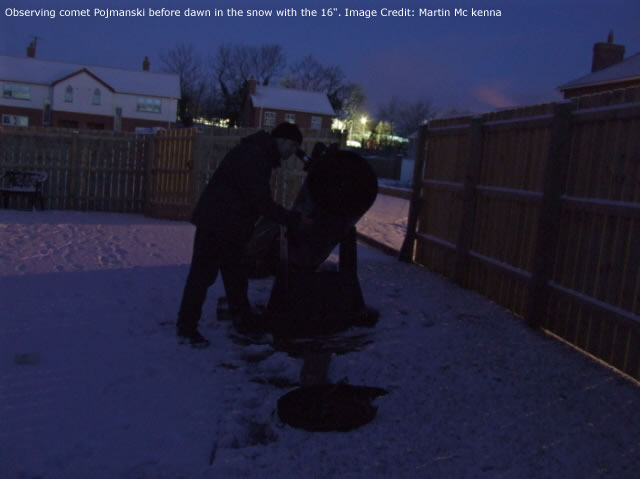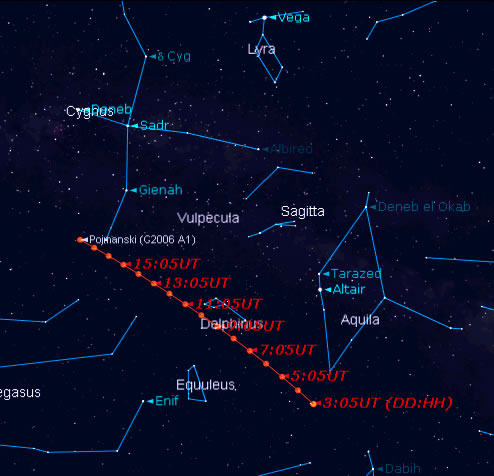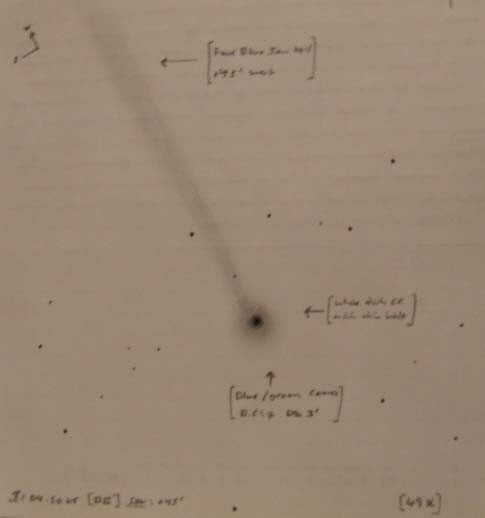

 |
 |
A selection of visual observations documenting new comet C/2006 A1 Pojmanski from February 27th - April 4th 2006.
 |
 |
I set my alarm for 05.00 BST this morning and when I awoke the sky was overcast however I was not put off because I had been reading the sky for much of the night and I knew it could clear at any minute..it did! I wrapped up and headed outside with my 10X50 Binos and 90mm ETX in hand and walked a considerable distance to my chosen vantage point up the site. The sky was awesome! The Milky way in Cygnus to the east and west of Deneb was like a cloud with the North American Nebula easy with the unaided eye. A long dark cloud bank hung over the comets position so with the binos I observed M81, M82, M51, M39, Double Cluster, M10, M12, M11, RCrB, TCrB, M13 and M27. |
I will have more luck tomorrow.
By 05.15 BST I was already out in my backyard setting up my 8" F/6.3 SCT scope and aligned my telrad on Altair. The sky was crystal clear with great trans with thick crunchy snow on the ground. The Milky way was like a cloud in Cygnus! At 49X I began a horizontal sweep low in the eastern sky beginning with the sky just above my garden fence and worked my way north, 30 seconds later at 05.25 I swept up the Comet and was immediately struck by how bright it was. My first impressions were that it looked similar to a globular cluster. The coma was a bright vivid blue colour, compact and well condensed with sharp edges and a hint of structure. The central condensation was a bright white disk and projecting away to the west was a lovely blue ion tail 45' long that broadened slightly with distance. Through the 10X50 binos I suspected the tail to be 2.5* long however I could not be certain. Once I knew were to look I seen the coma with the naked eye as a tiny soft blue star. Once the comet rose high enough I observed it with the 16" and alternated between it and the other equipment to enjoy the spectacle. This is a very nice comet!! I observed the comet until the twilight glow washed it out and ended the session at 06.20 BST. I text John Mc Connell and Kevin Black who was also observing it with his RCX!
My alarm went of at 05.00 BST and I headed out to the freezing pre dawn sky. Had another look at the comet this morning when I swept it up with the 8" at 49X however due to poor transparency in the lower sky sections I could not see it with the binos or naked eye. The coma is a + 3' wide, well condensed object at DC7/ vivid blue in colour with a mottled structure? sporting a white disk like central condensation and again looking similar to a blue wandering globular cluster. Blue ion tail seen for 15' due west however I am sure it is much longer than this. Lovely morning and a beautiful sky with snow on the ground. I was surprised just how quickly the glow of dawn crept up on me. Ended session at 06.05 BST. Also had a look at M71, M27, M57, M13 and Beta Cygni. - 2nd observation of this comet. Mag: 5.3 - 5.4 Dia: 3' D.C: 8....in Aquila
 |
This morning I made my third observation of C/2006 A1 (Pojmanski) at 04.50 LT. Using my 8" F/6.3 SCT at 49X I swept up the Comet in Delphinus located due east in a horizontal line from Gamma. The comet was fairly easy in 10X50 Binos and I could see it very faintly with the naked eye using both averted and direct vision as a blue, soft fuzzy blob. The waxing gibbous Moon was very low in the west and washed out some of the comets most delicate features however I did get a good view through the telescope. The coma was an obvious blue / green colour with a definite mottled texture reminding me of a globular cluster (I have not heard this reported yet) with generally sharp edges. The coma is an elliptical shape on the sun ward side however the western section seemed elongated away from the sun as it merged with the ion tail in a slight tear drop shape. At the centre of the coma was a very bright white disk - like central condensation that is now smaller in diameter than on my previous observation. Surrounding the 'CC' was a thin, well defined envelope of material. I rate the coma at DC:7 and overall looks to be a little softer and slightly fainter at mag 6.0? and a diameter of 3'. |
I could also see a VERY faint blue Ion tail extending for a minimum distance of 45' with a faint field star within the tail 'down wind' of the coma. I observed the Comet for 40 minutes until the glow of morning twilight ended the session. The coma is the most striking feature of this particular comet and should be observed soon before it fades further. At post Perihelion the comet will be now leaving the inner solar system tail first so if you haven't seen it now's the chance before it disappears from our sky! Here's a quick sketch.
 |
I forgot to mention that I thought I seen a jet in the form of a white, hairline linear feature pointing at an angle towards the sun but I am not certain. I am going to be following this comet for as long as I can. March 22/23rdI Observed Pojmanski myself this morning at at 03.15 BST located between Cygnus and Lacerta. With the 8" at 49X I seen a bright greenish moderately condensed coma with a bright but soft nuclear region. I seen a straight colourless ion tail pointing approx west for at least 30'. I may also have glimpsed one or more gas steamers shooting out from the coma at wide angles to the tail. The comet still looks nice and the coma is it's most distinctive feature. Best seen in a telescope. Mag: 6.2?, Dia: 3' DC: 6/ This is the 5th morning I have observed this comet March 28/29thHad a great observing session last night from 03.00 - 04.00 BST in the pre - dawn hours. The sky was incredible with excellent trans / seeing with a very dark sky background. Stars to mag 7 were glimpsed |
with the naked eye and the milky way in Cygnus was like a cloud with striking dark complex dust lanes. Using the 8" F/6.3 at 49X I hunted down C/2006 A1 Pojmanski which was located very close to a bright naked eye star in Lacerta. The comet was a blue circular fuzz ball, moderately condensed with a bright white soft central condensation. I could make out a faint, straight colourless ion tail for > 3' to the NW. The comet looked nice against a milky way background. Mag 7, D.C: 6, Dia: 3'.
Last night I observed from 02.00 - 04.00 BST with the 8" F/6.3 SCT at 49X. The sky was incredible, very black sky background - no lights on in neighbor hood at all, trans = 9, seeing = 7. The milky way was awesome, glowing like a cloud with complex vivid dark dust lanes extending the entire length of the sky into the east where it split in two bands within Aquila. Seen stars to mag 7.0 with naked eye and the variable star Chi Cygni on its rise to maximum like a Nova at mag 6.3?.
I tracked down C/2006 A1 Pojmanski in Lacerta, mag: 8.5, Dia: 3' DC: 5 blue circular coma which has become somewhat more diffuse and soft at its edges with a bright white soft central condensation. Seen faint colorless ion tail extending + 5' to the NW and a possible dust tail pointing south for 2' with a field star within the tail. Comet is still very easy to see.
Had a great observing session on the morning of the 5th before dawn. Trans = 7 - 8, Seeing = 7, low level murk, light high level cloud, very cold, semi dark sky with near 1st 1/4 Moon low in west. Using John Mc Connell's 8.5" Dobsonian with 40mm eyepiece I observed C/2006 A1 Pojmanski at 02.00 UT as a Circular patch of light that gradually got brighter toward the center. Coma is evidently fainter and more diffuse with soft edges and an overall subtle blue colour. No central condensation / false nucleus or tail visible. Comet looks nice in a dense milky way star field within Lacerta. Mag 8.7 Dia 2.5' DC: 5
Martin McKenna